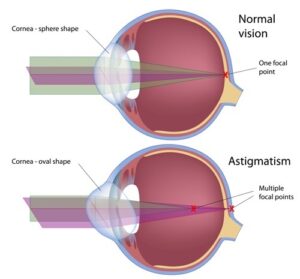Do you have cataracts? Do you think it may be time for cataract surgery?
Whether you need your cataracts removed or want more information about reducing your dependence on glasses with lens implant surgery, you are in good hands at Batra Vision. We only use the latest technology and are highly skilled at performing these vision-changing procedures.
In both cataract surgery and lens implant surgery, your eye surgeon removes the natural lens of your eye. After removing the natural lens, it’s replaced with an artificial intraocular lens or IOL.
These IOLs dramatically improve the quality and clarity of your vision. There was only one replacement lens option in the past: a standard monofocal lens.
Today, there are an array of IOLs to choose from when preparing for these procedures. In addition to a standard IOL, Batra Vision offers our patients premium IOLs that restore clarity to vision and can also correct other vision problems, like nearsightedness, astigmatism, and presbyopia.
You might wonder which lens is right for you with all the choices available. Learning about the differences between standard IOLs and premium IOLs and the options available in premium IOLs can help you make the best choice.
Keep reading to learn more about the differences between standard and premium IOLs!
Standard IOLs

A standard IOL is a monofocal lens. With a monofocal lens, you’ll be able to see with clarity while improving your vision at a single visual distance.
Patients who chose a standard, monofocal lens during cataract surgery or lens implant surgery will still need to wear glasses or contact lenses after the procedure. Using visual aids will allow you to see clearly at all distances following surgery.
One significant advantage of standard IOLs is that these IOLs are the only ones covered by insurance. If you have Medicare, monofocal IOLs may be the best fit for your budget when you’re having cataract surgery.
There is no additional out-of-pocket cost with this lens. Although premium IOLs can correct a broader range of vision, they are not typically covered by insurance plans.
If you don’t mind using glasses or contact lenses after cataract surgery or a lens implant procedure, a monofocal IOL may be the right choice for you.
Premium IOLs
At Batra Vision, we offer our patients many premium IOL options. These depend on your individual needs and visual goals after removing your cataracts or correcting your vision.
If you are looking for not just clearer vision but independence from visual aids, you should consider one of our wide array of premium IOLs options:
Multifocal IOLs

Multifocal IOLs offer clear vision at both near and distant ranges. These IOLs have two regions with different vision powers, like bifocal glasses lenses.
Additionally, patients who opt for multifocal lenses say that they experience fewer instances of halos or other visual disturbances. With a multifocal lens, you may still need to use reading glasses for close-vision tasks, like texting or reading a menu in a restaurant.
Depending on your vision prescription, you may still need to wear glasses or contact lenses to correct your vision completely. Many multifocal IOLs come in a toric model, making them an excellent option if you have astigmatism.
Some patients with multifocal IOLs find that they don’t prevent glare as well as other IOLs and may not offer as much visual contrast as monofocal or toric lenses.
Toric IOLs

Toric IOLs are the only IOLs specifically designed to correct astigmatism. Astigmatism occurs when the lens of the eye is an irregular shape and curve.
When this occurs, it makes your vision look blurry or distorted. You may also suffer from other refractive errors like nearsightedness and farsightedness.
Toric IOLs have different vision powers in other parts of the lens to compensate for the asymmetry of the shape of the eye. Offsetting the asymmetrical shape of the eye helps correct many of the vision problems caused by astigmatism.
Patients with nearsightedness usually need visual aids as toric lenses do not correct distance vision. However, if you choose an advanced lens implant that enables an extended range of vision and astigmatism correction, this won’t be an issue.
Many other premium IOLs come in toric versions, but only your ophthalmologist can assess which specific IOL is suitable for your eyes.
Trifocal IOLs

A trifocal IOL offers corrected vision at three ranges: near, intermediate, and far. They provide the most comprehensive correction of your vision.
Many patients that choose a trifocal lens find that they no longer need to rely on glasses or contact lenses to correct their vision. With a trifocal IOL, you can now do tasks that you may have needed glasses to perform, like using a computer, applying makeup, or reading a road sign without needing visual aids.
These premium IOLs offer complete vision correction.
Accommodating IOLs
Accommodating IOLs work similarly to your natural eye, making them highly innovative. These premium lenses work by moving with your eye to accommodate focus at different distances.
They can change shape as they move, like the eye’s natural lens. These unique IOLs are primarily used for cataract treatment but are increasingly used to restore near vision affected by aging, eliminating the need for reading glasses.
Light Adjustable Lens

The Light Adjustable Lens is the first and only premium lens that allows you to customize your vision after surgery. Like other premium IOLs, it’s implanted before adjusting your vision to your specifications with a series of short in-office light treatments.
Batra Vision is the only eye care provider in San Leandro to offer this advanced premium IOL option! The best way to determine whether a standard IOL or a premium IOL is right for you is to consult with a Batra Vision eye care professional.
We work with you so that you get the exact lens that will give you the best vision results! If you need cataract surgery or are thinking about lens implant surgery, schedule an appointment today at Batra Vision in San Leandro, CA!

 Follow Us!
Follow Us!